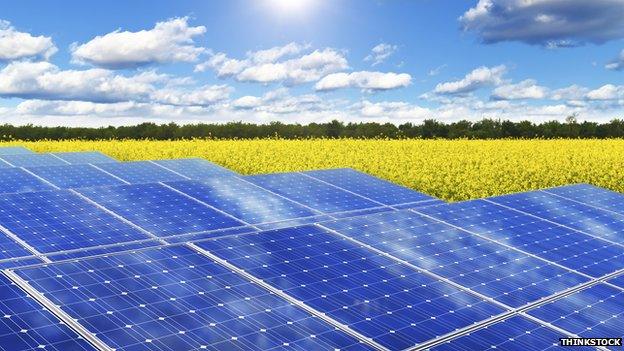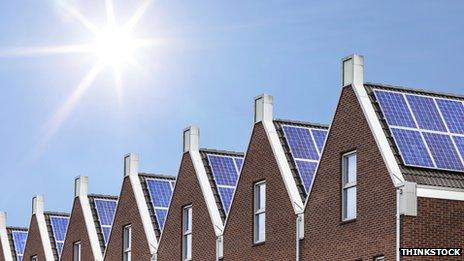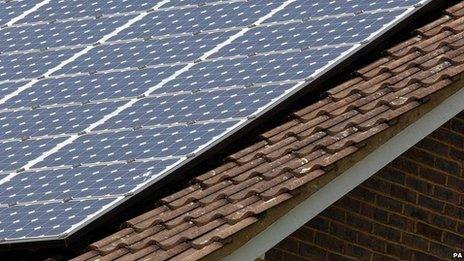Government to slash subsidies for large scale solar farms
- Published

The government has unveiled proposals to limit the subsidies paid to large solar farms from next April.
Owners of installations bigger than 5 megawatts (MW) will have to compete with other renewables for financing.
The Department of Energy & Climate Change (Decc) says it wants to encourage the development of smaller scale and community energy production.
Campaigners have condemned the move, saying it will undermine investor confidence in the renewable sector.
The government wants to draw a close to the current system two years before it was projected to end.
Many parts of Southern England have seen a boom in solar power generation in recent years. There is currently enough photo-voltaic installed capacity to power 620,000 homes.
Land owners have been encouraged to switch to "solar farming", thanks to a subsidy regime that can earn them around £1,000 per acre per annum for up to 25 years.
The government proposals, external highlight concerns that this switch to solar is happening far too quickly. They are worried that by 2017 there will be more solar energy being produced than the UK could afford.
Cash fight
Now, in a move that has been trailed for some time, it is set to bring forward a change to the way that solar producers receive financial support.
Under existing regulations, PV installations are subsidised through the Renewables Obligation, external system.
This "one way" mechanism means that generators get paid regardless of any changes in either the price of electricity or their costs of production.

The government is clearly signalling that it prefers mounted solar panels to ones on the ground
If these costs of production drop, as has happened to solar power over the past four years, there is no way for the government to claw back any of the subsidy.
The government now wants to end this system two years early and make solar installations larger than 5MW compete for subsidies under a new method called "contracts for difference, external".
Under the Decc proposals, large scale solar farms would have to fight for cash with what the government calls "established technologies" including onshore wind, energy from waste with combined heat and power and big hydro-electric installations.
Up in the air
The proposals also clearly show a government preference for solar panels to be placed on top of industrial buildings rather than on the ground in fields.
Tariffs paid for building mounted solar panels would decline at a slower rate than for ground mounted panels according to the plans.
Community-owned schemes though will benefit under the proposals, with the government suggesting that the size of solar or onshore wind projects that can benefit from feed-in tariffs be doubled to 10MW.
Solar industry sources though were unhappy at the changes outlined.
"This policy proposal will undermine investor confidence in the entire UK renewable energy sector, by removing at a stroke the short and medium-term policy certainty required for major project investments," said Seb Berry from Solarcentury.
"Large-scale solar is already significantly cheaper than offshore wind and will be competitive with onshore wind by 2017. In deliberately setting out to strangle the growth of cheaper solar from 2015, Secretary of State [Ed] Davey can no longer claim that government policy will deliver the most cost-effective mix of technologies by 2020."
Campaigners were also upset, claiming that the government has completely underestimated the potential of renewables.
"Every time a renewable energy technology starts to do well it gets hit by a wave of Government uncertainty, which pushes up costs and threatens jobs and investment," said Alasdair Cameron from Friends of the Earth.
"Attacking large-scale solar parks, while doing almost nothing to boost rooftop systems, is another sign of this Government's piecemeal approach to policy making. Solar power is cheap, popular and essential for tackling climate change and energy security."
Follow Matt on Twitter, external.
- Published11 April 2014
- Published19 March 2014

- Published6 February 2014
